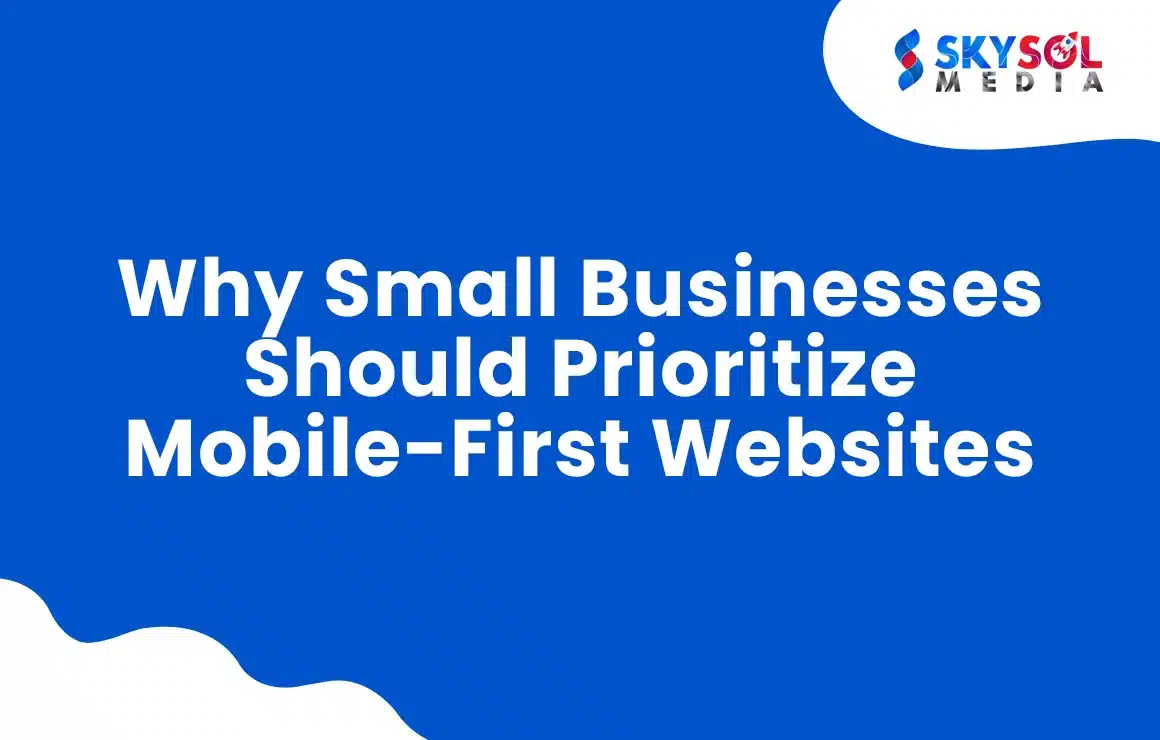Need help? Call us:
+92 320 1516 585
- Web Design And Development
- Graphic Designing
- Search Engine Optimization
- Web Hosting
- Digital Marketing
- CRO Services
- Brand Development
- Social Media Marketing
- PPC Marketing
- Content Marketing
- ERP Solutions
- App Development
- Game Development
- Printing Services
- Video Production
- Artificial Intelligence
- Data Entry
- Theme And Plugin Development
- Product Photography
- Software Development
- App Development
- Artificial Intelligence
- Brand Development
- Content Marketing
- CRO Services
- Custom Theme And Plugin Development
- Data Entry
- Digital Marketing
- ERP Solutions
- Game Development
- Graphics Designing
- PPC Marketing
- Printing Services
- Product Photography
- SEO
- Social Media Marketing
- Software Development
- Unique Category
- Video Production
- Web Design & Development
- Web Hosting
Why Small Businesses Should Prioritize Mobile-First Websites
In today’s digital-first world, having an online presence is no longer optional for small businesses; it is essential. As we move further into 2025, one…

In today’s digital-first world, having an online presence is no longer optional for small businesses; it is essential. As we move further into 2025, one trend stands out as critical for success: mobile-first websites. With over 60% of global internet traffic coming from mobile devices and search engines like Google prioritizing mobile-friendly websites in their rankings, a mobile-first approach is no longer a luxury—it’s a necessity.
This blog will explore why small businesses must prioritize mobile-first websites, the benefits they can reap, and the steps they need to take to stay competitive in the ever-evolving digital landscape.
The Mobile-First Revolution
The concept of mobile-first web design stems from the dramatic rise in smartphone usage. According to recent statistics, mobile devices are the primary tool for browsing, shopping, and engaging with online content. By designing a website with responsive design and mobile users in mind first, businesses can ensure a seamless and engaging experience across all devices.

Why Mobile-First Matters in 2025
- Google’s Mobile-First Indexing: Google now primarily uses the mobile version of a website for indexing and ranking. If your site isn’t optimized for mobile, your rankings will suffer, potentially reducing your visibility to potential customers.
- User Expectations: Modern consumers demand fast, easy-to-navigate websites. A clunky, non-responsive website can frustrate users and drive them to competitors.
- E-Commerce Growth: Mobile commerce (m-commerce) is booming. A report by Statista predicts that mobile transactions will account for over 70% of all e-commerce sales in 2025. If your site isn’t mobile-friendly, you risk missing out on this massive revenue stream.
Key Benefits of Mobile-First Websites
In today’s digital landscape, where mobile devices dominate internet usage, adopting a mobile-first approach is no longer optional—it’s essential. Mobile-first websites cater to the growing number of users accessing the web via smartphones and tablets, ensuring seamless functionality and a superior browsing experience. By prioritizing mobile users, businesses can unlock significant advantages, which are highlighted below.
1. Enhanced User Experience (UX):
A mobile-first website prioritizes simplicity, speed, and ease of use. Small businesses can engage users better by offering:
- Faster loading times.
- Intuitive navigation designed for smaller screens.
- Touch-friendly elements like larger buttons and streamlined forms.
2. Improved SEO Rankings:
Search engines reward mobile-friendly websites with higher rankings. Features like responsive design, quick load times, and structured data optimization make it easier for small businesses to rank on the first page of search engine results.
3. Increased Engagement and Conversion Rates:
When users can easily browse products, read content, or contact a business on their phones, they are more likely to stay longer and take desired actions, such as making a purchase or submitting an inquiry.
4. Cost-Effectiveness:
Designing a mobile-first, responsive website eliminates the need to maintain separate desktop and mobile versions. This streamlined approach saves small businesses time and money in the long run.
5. Staying Competitive:
In 2025, businesses that fail to adapt to mobile-first trends risk losing out to competitors who prioritize mobile users. A mobile-first website ensures that your brand remains relevant and competitive in a crowded market.
Challenges Faced by Small Businesses
While the benefits of mobile-first websites are clear, small businesses often face challenges such as:
- Limited Budgets: Many small businesses operate on tight budgets, making it difficult to invest in high-quality web design and development.
- Technical Expertise: Creating a mobile-first website requires knowledge of responsive design, fast-loading frameworks, and usability testing. Without in-house expertise, small businesses may struggle to implement these features effectively.
- Time Constraints: Running a small business leaves little time for managing a website overhaul. Balancing daily operations with a website redesign can feel overwhelming.
Solution: Partnering with experts like SkySol Media can help small businesses overcome these challenges. With years of experience in WordPress development and mobile-first design, we create cost-effective, scalable, and user-friendly websites tailored to your unique needs.
Key Features of a Mobile-First Website
To build a successful mobile-first website, small businesses should focus on the following features:
1. Responsive Design:
Ensure the website adapts seamlessly to different screen sizes, providing a consistent experience across mobile, tablet, and desktop devices.
2. Fast Loading Speeds:
Optimize images, use caching tools, and minimize code to ensure your website loads in under three seconds. Speed is a critical factor for both user experience and SEO rankings.
3. Mobile-Friendly Navigation:
Design menus, buttons, and forms that are easy to use on small screens. Simplify navigation to minimize user frustration.
4. Touch-Friendly Elements:
Ensure clickable elements like buttons and links are large enough to avoid accidental taps.
5. Content Prioritization:
Focus on delivering concise, relevant information that users can quickly access. Mobile users value efficiency and convenience.
6. Mobile-Specific Features:
Leverage mobile capabilities like click-to-call buttons, GPS-enabled directions, and mobile payment options to enhance user experience.
Steps to Implement a Mobile-First Website
Here’s how small businesses can transition to a mobile-first website in 2025:
1. Analyze Your Current Website:
Use tools like Google’s Mobile-Friendly Test or PageSpeed Insights to assess how well your site performs on mobile devices. Identify areas for improvement.
2. Partner with Experts:
Collaborate with a professional web development agency like SkySol Media to design and implement a mobile-first strategy tailored to your business goals.
3. Choose the Right Platform:
WordPress remains an excellent choice for small businesses due to its flexibility, vast plugin ecosystem, and mobile-friendly themes.
4. Prioritize Core Web Vitals:
Focus on metrics like loading performance, interactivity, and visual stability to enhance user experience and boost SEO rankings.
5. Test and Optimize:
Regularly test your website’s performance on different devices and browsers. Gather user feedback and make adjustments as needed.
Success Stories: Mobile-First Small Businesses
Small businesses that have embraced mobile-first websites are already seeing significant results. For instance:
- Local Retail Stores: Retailers with mobile-optimized e-commerce platforms report increased sales and higher customer retention rates.
- Service-Based Businesses: Professionals like plumbers and electricians benefit from click-to-call buttons, making it easy for customers to contact them instantly.
- Restaurants and Cafes: Mobile-friendly websites with integrated online ordering and reservation systems attract more customers.
Why SkySol Media is Your Mobile-First Partner
At SkySol Media, we understand the unique needs of small businesses. Our team specializes in creating mobile-first WordPress websites that combine aesthetics, functionality, and performance. With a focus on responsive design, SEO optimization, and user-centric features, we help businesses thrive in the digital age.
Our Services Include:
- Custom WordPress development.
- Mobile-first e-commerce solutions.
- Speed and performance optimization.
- Ongoing support and maintenance.
Contact SkySol Media today to discuss how we can help you create a mobile-first website that drives results in 2025.
Conclusion
As mobile usage continues to grow, prioritizing a mobile-first website is no longer optional for small businesses. It’s the key to improving user experience, boosting SEO rankings, and staying competitive in an increasingly digital marketplace. By investing in a mobile-first strategy, small businesses can unlock new opportunities, reach wider audiences, and future-proof their online presence.
Let SkySol Media be your partner in this journey. Together, we can create a website that not only meets the demands of today’s mobile users but also positions your business for long-term success.
- Related Tags: Mobile-First Websites
Don’t forget to share it
Table of Contents

We’ll Design & Develop a Professional Website Tailored to Your Brand
Enjoy this post? Join our newsletter
Newsletter
Related Articles
Web Development Meets Marketing: The SkySol Media Advantage
How to Make Your WordPress Site Lightning Fast in 2025-26
How Custom Plugin Development Can Solve Your Unique Business Problems
The Ultimate WordPress Speed Optimization Checklist for 2025-26
How to Future-Proof Your WordPress Site: Security, Speed & Scalability Tips
This website uses cookies to improve your experience.
By using this website you agree to our Privacy Policy.






